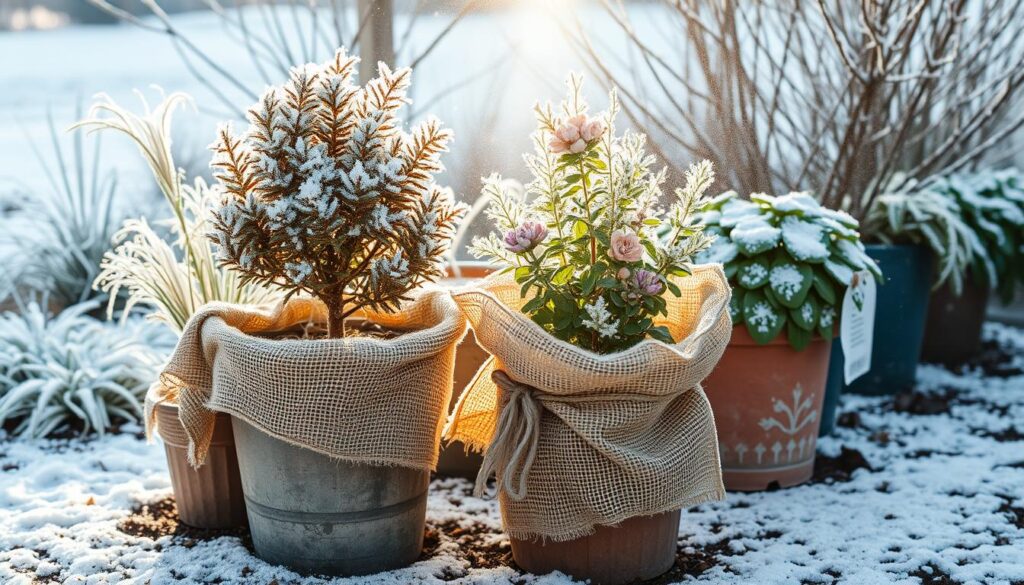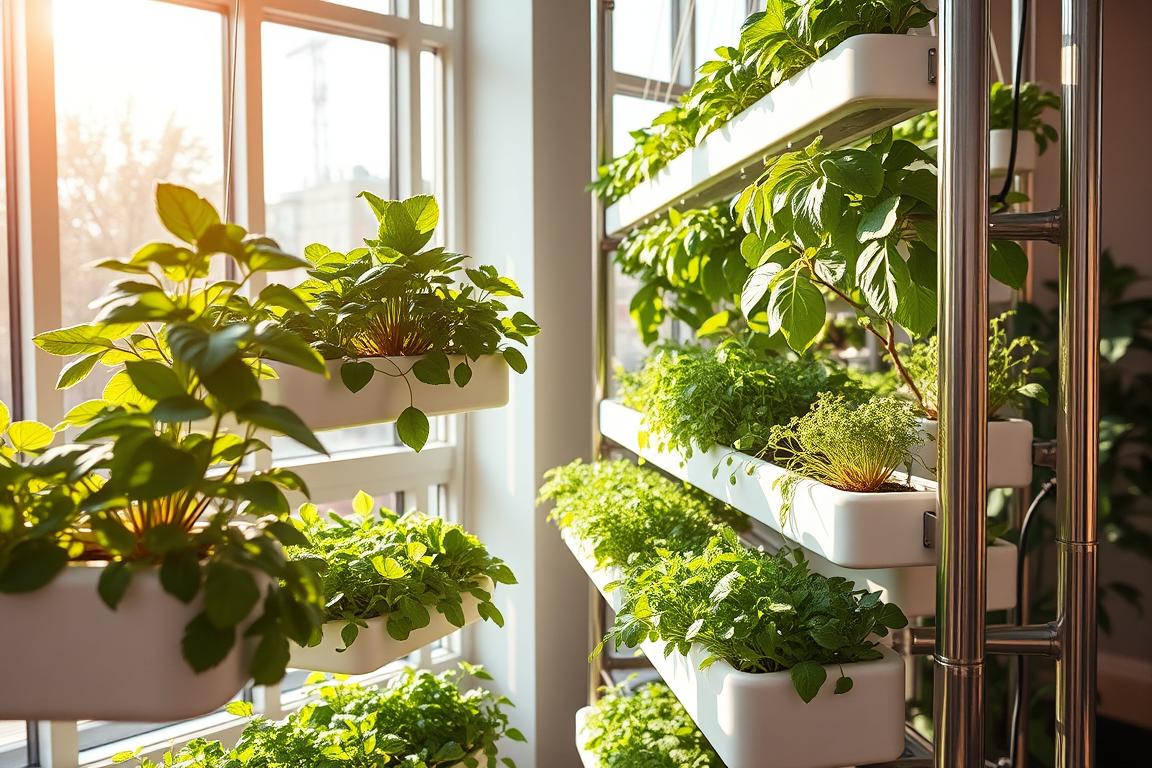When winter arrives, many gardeners think their container gardens must wait until spring. But, with the right approach, you can keep your garden alive and vibrant even in the cold. This guide will offer expert advice to help your plants not just survive but flourish during winter.
Key Takeaways
- Understand the unique cold-weather requirements of plants for successful winter container gardening
- Choose the right containers and materials to protect plants from harsh winter conditions
- Discover a variety of cold-hardy vegetables, flowers, and herbs that can be grown in containers during the winter months
- Learn effective techniques for insulating and protecting your container plants from frost and extreme weather
- Develop effective watering and maintenance strategies to keep your winter container garden healthy and thriving
Essential Winter Container Gardening Basics
To have a great winter container garden, you need to know about cold-hardy plants and when to plant. Learning these basics helps gardeners create beautiful winter displays. These displays can brighten up the cold months.
Understanding Cold Weather Plant Requirements
Cold-hardy plants have special features to survive the cold. They have thick leaves, waxy coatings, and can go dormant. It’s important to pick plants that can handle the cold for your winter containers.
Best Times for Winter Container Planting
- Early fall (September-October): Plant cool-season annuals, perennials, and bulbs for winter interest.
- Late fall (November-December): Add hardy greens, root vegetables, and flowering plants that can brave the cold.
- Early spring (March-April): Refresh containers with new cold-hardy crops and colorful blooms.
Basic Equipment and Materials Needed
For a successful winter container garden, you’ll need a few key tools and materials. These include frost-resistant pots, a good potting soil mix, and ways to protect from the cold. Having these basics helps keep your plants healthy and thriving all winter.
| Equipment/Material | Description |
|---|---|
| Frost-Resistant Containers | Choose sturdy, insulated pots like ceramic, terracotta, or resin that can handle freezing. |
| Potting Soil Mix | Use a nutrient-rich, well-draining potting soil made for container gardening. |
| Cold Weather Protection | Invest in row covers, cold frames, or other insulation to protect plants from frost and extreme cold. |
By learning the basics of winter container gardening, you can create a beautiful cold-weather display. With the right plants, planting times, and protection, your containers can add color and fresh produce all winter.
Selecting the Right Containers for Winter Growing
Choosing the right containers is key for winter container gardening. The right container protects your plants from cold and helps them survive. Let’s explore what to look for in the perfect containers for your winter garden.
Insulation and Drainage
Insulation is crucial to keep plants warm in winter. Look for containers like terracotta, ceramic, or wooden planters. These materials keep the roots warm and prevent damage.
Drainage is also vital. Waterlogged soil can cause root rot. Choose containers with good drainage holes or add gravel for better drainage.
Size and Portability
The size of your containers matters, especially in small spaces. Pick larger, deeper pots for your winter plants. This gives them enough room to grow. Containers on casters make it easy to move plants to safe spots during bad weather.
| Container Material | Insulation Properties | Drainage Considerations |
|---|---|---|
| Terracotta | Excellent insulation | Excellent drainage |
| Ceramic | Good insulation | Good drainage |
| Wooden | Good insulation | Moderate drainage |
| Plastic | Poor insulation | Good drainage |
By choosing the right containers, your winter garden will thrive. Your plants will be well-protected and have a great chance of growing well in the cold months.

“The right container can make all the difference in your winter container gardening success.”
Cold-Hardy Plants and Vegetables for Container Growing
Winter container gardening shines with cool-season crops, winter greens, hardy vegetables, and potted herbs. These plants thrive in cooler weather. They keep producing long after warm-weather plants stop.
Frost-Resistant Vegetables
Kale, spinach, Swiss chard, and beets are great for winter gardens. They handle freezing well and taste sweeter after frost. Root veggies like carrots and radishes also grow well in containers, offering fresh produce all winter.
Winter-Blooming Flowers
Winter brings its own beauty with winter-flowering plants. Pansies, violas, and hardy snapdragons add color and cheer. They bloom even when it’s cold.
Cold-Weather Herbs
Rosemary, thyme, and parsley are perfect for winter containers. These herbs add flavor to your dishes, making them fresh and fragrant.
“Embracing the challenges of winter container gardening can open up a world of fresh, flavorful possibilities right at your doorstep.”
Choosing the right plants for winter gardening lets you enjoy fresh produce even in cold weather. With some planning, your outdoor space can be vibrant and productive all year.
Creating the Perfect Winter Potting Soil Mix
As winter gets closer, making the right container soil mixes is key for your winter garden. The best potting mix gives plants the nutrients they need. It also helps with drainage and keeps plants warm during cold weather.
For the best soil mix in winter containers, balance is important. Start with a good potting mix that’s light and full of air. Look for mixes with peat moss, compost, and vermiculite or perlite.
- Peat moss keeps moisture and nutrients in, and compost adds organic matter and good bugs.
- Vermiculite or perlite helps with drainage and air, so roots don’t get too wet.
To make your container soil mixes even better, add a layer of mulch or shredded bark on top. It keeps the soil warm and stops moisture from escaping too fast.

Remember, the best potting mix for winter containers depends on your garden and plants. Try different mixes until you find the perfect one for your winter garden.
Protecting Plants from Frost and Extreme Weather
As winter gets closer, gardeners need to protect their plants from frost and extreme weather. Using frost protection can help plants grow longer and keep cold frames and miniature greenhouses safe.
Insulation Techniques
Insulation is key to keeping plants warm. You can wrap containers with burlap, straw, or bubble wrap. This traps heat and stops frost damage. Also, placing containers in a warm spot, like against a wall, helps a lot.
Using Protective Coverings
- Cold frames or miniature greenhouses are great for protecting plants. They trap heat and keep plants safe from the weather.
- Use lightweight fabrics like row covers or plant blankets to cover plants. These can be removed during the day for sunlight and air.
- Use items like cardboard boxes or plastic jugs as mini-greenhouses. They’re easy to make and work well.
Emergency Weather Protection Methods
Be ready for sudden cold or bad weather with a frost protection plan. Keep old sheets, towels, or tarps ready to cover your plants. This adds extra insulation and prevents damage from cold temperatures.

With these frost protection and season extension tips, you can keep your plants safe and healthy all winter. Using cold frames and miniature greenhouses is also a good idea.
Winter Watering and Maintenance Strategies
As winter comes, taking care of your container garden is key. You need to find the right balance in watering and upkeep. Watering right is crucial to keep your plants alive and looking good.
Adjusting Your Watering Schedule
In winter, plants need less water because it’s colder and they grow slower. It’s vital to change your watering schedule to avoid too much water. Check the soil often and water only when it’s dry up to two inches deep.
Maximizing Winter Sunlight
Winter sunlight is weaker and lasts less time. So, it’s important to place your containers where they get the most sun. Move your pots around to make sure all sides get sunlight.
Pruning for Winter Survival
Pruning in winter is also important. Cutting off dead or weak parts helps your plants survive the cold. It makes them focus on staying alive.
| Watering Technique | Frequency | Benefits |
|---|---|---|
| Deep Watering | Every 7-10 days | Encourages deep root growth and better drought resistance |
| Misting | 2-3 times per week | Increases humidity and prevents leaf scorch |
| Soil Moisture Monitoring | Daily | Ensures proper watering based on individual plant needs |
Using these watering techniques and care tips, your winter garden can thrive. Even in the toughest weather, your garden can stay beautiful.
Managing Pests and Diseases in Winter Containers
Keeping plants healthy in winter containers is a big job. You have to watch out for pests and diseases like aphids and powdery mildew. But, with the right steps and natural solutions, your garden can stay vibrant even when it’s cold.
Common Winter Plant Problems
Plants in containers are more likely to get spider mites, fungal infections, and even rodent damage in winter. Spotting these issues early is crucial to fix them before they get worse.
Prevention and Treatment Methods
Regular checks, the right watering, and organic treatments can stop many problems. Also, make sure plants have enough air and aren’t too close together to avoid diseases.
Natural Pest Control Solutions
For pests, choose green solutions like introducing beneficial bugs, neem oil, or homemade garlic or pepper sprays. These methods can fight off pests without harming your garden’s balance.
FAQ
What are the benefits of winter container gardening?
Winter container gardening lets you grow cold-hardy plants. It extends your gardening season. You can enjoy fresh produce or beautiful blooms even in cold months. It’s a great way to keep gardening all year, even in small spaces.
What types of containers are best for winter gardening?
Insulated, frost-proof containers are best for winter. Look for terracotta, ceramic, or thick plastic. Make sure they have good drainage and are big enough for the plants’ roots.
What are some cold-hardy vegetables and plants for winter containers?
Great options include kale, Brussels sprouts, and Swiss chard. Spinach, pansies, violas, and cold-weather herbs like rosemary and thyme are also good. These plants handle cooler temperatures and shorter daylight in winter.
How do I create the perfect potting soil mix for winter containers?
A good potting mix is key for winter containers. Mix equal parts compost, perlite or vermiculite, and high-quality potting soil. This mix drains well, is rich in nutrients, and keeps plants warm.
How do I protect my winter container plants from frost and freezing temperatures?
To protect plants, wrap containers with bubble wrap or burlap. Place them in sheltered spots. Cover them with frost blankets or cold frames. This keeps roots warm and prevents damage from harsh weather.
How often should I water my winter container plants?
Watering needs are lower in winter. Keep the soil slightly moist. Check it often and water when it’s dry an inch or two down. Avoid too much water to prevent root rot.
How do I manage pests and diseases in my winter container garden?
Watch for pests like aphids and spider mites, and diseases. Regular checks and removing sick leaves help. Use eco-friendly pest control if needed. Good air flow and not crowding plants also helps prevent problems.
Can I grow vegetables in winter containers?
Yes, you can grow cool-season veggies like kale and spinach in winter containers. These hardy crops do well in cooler temperatures and shorter daylight.






